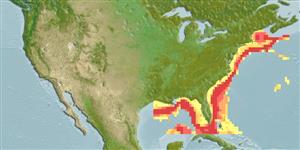Common names from other countries
Environment: milieu / climate zone / depth range / distribution range
Ekologi
; kisaran kedalaman 0 - 2243 m (Ref. 104446). Temperate, preferred 22°C (Ref. 107945); 44°N - 23°N, 94°W - 62°W
Western Atlantic: From Emerald Bank, Nova Scotia, Canada, and the Gulf of Maine to the Mid-Atlantic Bight and the Gulf of Mexico.
Length at first maturity / Size / Weight / umur
Maturity: Lm ?, range 7 - 9.1 cm Max length : 18.0 cm CW jantan/; (Ref. 96186); 13.6 cm CW (female)
Adult females do not mate every year. After mating, females carry fertilized eggs on their pleopods for up to 9 months until the larvae are released (Ref. 2765). Brood sizes range from 160,000 to 270,000 eggs, and fecundity increases with female body size (Ref. 2766).
rujukan utama
Acuan | Koordinator | mitra
Abellán, L.J.L., E. Balguerías and V. Fernández-Vergaz. 2002. (Ref. 2677)
Status IUCN Red List (Ref. 130435: Version 2024-1)
status CITES (Ref. 108899)
Not Evaluated
Not Evaluated
penggunaan manusia
Perikanan: komersial
FAO - Perikanan: landings | FishSource | Sea Around Us
Alat, peralatan
Sumber internet
Estimates based on models
Preferred temperature
(Ref.
115969): 3.8 - 12.9, mean 6.4 (based on 34 cells).
keancaman
Low vulnerability (10 of 100).
